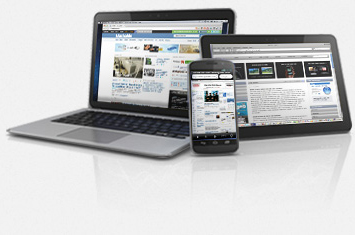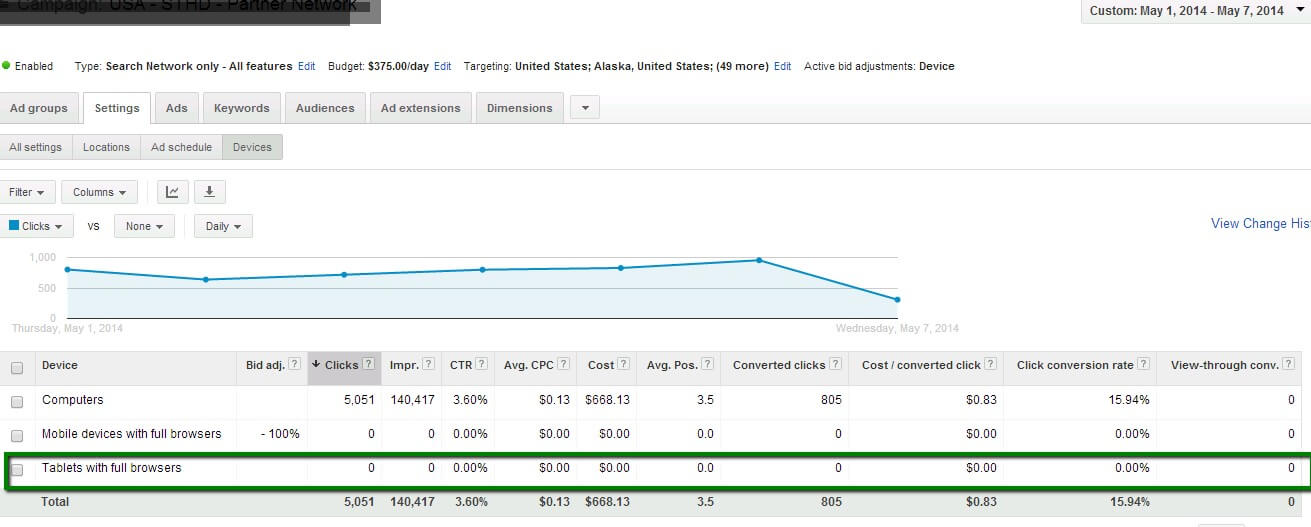How To Run Single-Device Only Enhanced Campaigns. It Can Be Done!
When I speak about Enhanced Campaigns, I invariably get an audience question like this: “How can I create single-device campaigns? I know it’s possible somehow, tell me how!” I recently figured out the answer. Why The Need For Single-Device Campaigns? I am not usually a proponent of AdWords workarounds. I typically encourage businesses to work […]
When I speak about Enhanced Campaigns, I invariably get an audience question like this:
“How can I create single-device campaigns? I know it’s possible somehow, tell me how!”

I recently figured out the answer.
Why The Need For Single-Device Campaigns?
I am not usually a proponent of AdWords workarounds. I typically encourage businesses to work with the system and concentrate their efforts on making their landing pages and funnel work well within the AdWords targeting criteria limits.
However, the device targeting limits of Enhanced Campaigns just inherently don’t work for some businesses and paid search contracts. For instance, an advertiser might have an online magazine specifically for tablets — I once had a client with this exact product (luckily it was before Enhanced Campaigns). Or, perhaps a mobile app like Uber or Hotels Tonight has zero interest in (and no real content for) desktop traffic.
More common are simple siloed budget problems. As paid search professionals, we are often retained by only a segment of a large business. For instance, those in the “US Mobile Digital Acquisitions Department” of a huge multinational corporation have allotted budgets and goals that only apply to a single device.
Unfortunately, influencing the org structure and budget allocation of a huge organization is not usually within the paid search person’s scope. In these scenarios, we are constantly apologizing for our inability to align 100% of our spend within the device strategy the client has requested.
Recently, I had a client that truly required 100% desktop traffic. When a conversion is executed on their site, they get revenue from their partners. With the set-up of their revenue model, they don’t get paid for conversions that happen on tablets or mobile (though they can be executed).
Mobile is easy — we just put a -100% bid modifier. Tablet, on the other hand, was hampering performance and scale. We had to “round-down” our CPCs to account for the fact that 15% of traffic and conversions were worthless tablet ones.
Then, we discovered how to suppress 100% of tablet impressions.
How Did We Do It?
First, we removed the AdWords pixel from firing on tablet conversions. Then, we switched to CPA target bidding. This advertiser has a very easy (and cheap) conversion action — basically a button click. Within three days, this suppressed 100% of tablet impressions. We are sending 100% desktop traffic now.
This got me thinking. How could you “manufacture” the same situation for any advertisers in order to send 100% of traffic from any single device? It requires a high volume of “conversions” with a low CPA… and then I figured it out.
AHA! How to Send Single Device Traffic
A tweak on the methodology will work to send 100% desktop, mobile or tablet traffic within Enhanced Campaigns for any advertiser, even those with high CPA targets.
Here’s how it works: You set the AdWords conversion pixel to fire when a visitor hits your landing page for only the device that you want to target (and not the others). Then, you use CPA bidding. Think of your “conversion” as simply a page visit on the desired device. The CPA that you set will essentially be analogous to a CPC.
Exact implementation will vary depending on the systems you use for tracking, rendering pages and firing pixels. However, let’s walk through an example for an advertiser with a responsive site design, that wants only mobile traffic and is using Google Tag Manager.
In this scenario, you’d first make sure your destination URLs are using the {device} value track parameter. Then, set up a rule in Google Tag Manager to fire the AdWords conversion pixel on every visit that where the device is mobile and the referrer is Google.
If you are trying to apply this to only certain campaigns within an account, you would also want to create parameters that capture the source campaign and pixel firing rules that addressed the source campaigns, too. Using that method, you could actually segment campaigns for each device like back in the old days. (Although I don’t recommend doing this simply for nostalgia’s sake — more on that later.)
Once your pixel firing is set, go into your campaign settings tab and set your campaigns to max CPA bidding. This is within the “Advanced Options” in the Bid Strategy section. Then, set your “max CPAs” to what you’d like to pay for a max CPC.
Note: You will need to send 15 “conversions” first in each campaign — remember, these are just visits in our workaround, before you are able to change your campaign to CPA bidding.
Google’s algorithm is now working for you to only deliver the “converting” traffic (i.e., visits from your desired device). Depending on your click volume, within a couple hours or days, you will be sending 100% of your traffic from your desired device.
But What About Your “Real” Conversions?
Since you are using your main “conversion” as a page visit, how do you capture the actual conversion action? To do this, you’ll need to set up another conversion in AdWords.
Make sure your bidding is set to run on only “Clicked Conversions” (that primary page visit metric). Then, add another conversion that fires for your “real” conversion event. If there is dynamic revenue being captured, make sure you set it to record that. If not, I’d suggest setting the “value” at a 1.
This will allow you to use the “Total Conversion Value” column to see how many “real” conversions are coming through in your reporting. Alternately, you’d need to download most reports and subtract the Converted Clicks column from the Conversions column in Excel to get your “actual” conversion numbers.
The use of third-party platforms such as Marin or Kenshoo can also be used to track the “actual” conversions. That said, you still should set up the suggested “real” conversion in AdWords also to take advantage of the UI reporting that only exists in AdWords (such as search term reporting).
Before You Go Segmenting All Your Campaigns For Device…
This method does create some campaign management inefficiencies; it’s not what the system was designed to do. As such, I’d strongly suggest that you do not use this simply to segment by the three devices like we used to do before Enhanced Campaigns.
Instead, work within the system to align your user experience and marketing goals with an Enhanced Campaign world. In fact, I suggest that you only use this method if you really absolutely have to in order to efficiently advertise within AdWords.
So, why publish a workaround that probably applies to only 5% of accounts? It’s time to restart the conversation on the forced device competency of Enhanced Campaigns. Google has done a good job with Enhanced Campaigns forcing many advertisers to learn to value mobile for their business. For many, this push has taken them to new levels. We agree — it really is a cross-device world.
However, for many businesses, tablets do not actually perform anything like desktop (don’t get me started on tablets and GDN). For other advertisers, their businesses are truly entirely built for mobile or desktop.
For paid search professionals, constant explanation and apologies for our inability to target our budgets to our client’s device-allocated allowances creates unnecessary client relationship friction. Having to execute workarounds like this in AdWords, to do something that can be done in Bing Ads, really should not be necessary.
So, if your business model or budget is truly device-specific, this will enable you to advertise within AdWords effectively on only the device(s) that your marketing spend applies to. However, the bigger issue remains — with the early irrational scuttlebutt about Enhanced Campaigns now calmed, most advertisers have a very rational and results-based view of the system. The data show it, client’s want it — it’s time for Google to reexamine the forced-device components of Enhanced Campaigns.
Contributing authors are invited to create content for Search Engine Land and are chosen for their expertise and contribution to the search community. Our contributors work under the oversight of the editorial staff and contributions are checked for quality and relevance to our readers. The opinions they express are their own.
Related stories
New on Search Engine Land



